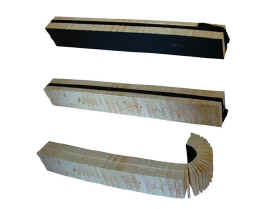![]()
Pollinator Paradise Home
Leafcutting bees and alfalfa Research slide shows
Bee management
Philosophy
Links
Contact us
The
Solitary Bee Web Rearing Solitary Bees
Suppliers References
Bee Gardens FAQ
Links
New Mexico Native Bee Pollinator Project About
Dr. Strickler Contact
Us
Bee Nests and Accessories
Bee Photo
Gallery
![]()
BINDERBOARD®patent # 5,372,535 and # 5,618,220loose cell management systems for solitary bees. |
|||
|
Click on photo for a closer look.
|
 |
Binderboards® for orchard bees. now with bolts for increased tension |
|
What is BINDERBOARD®?Binderboard® is a simple, efficient, automated system for managing leafcutting bees. It utilizes a stack of laminates attached at the back with dark PVC cloth. The laminate layers open like a book, hence the name Binderboard®. The simple addition of a permanent backing allows for rotary movement in a processing machine. The board opens, bee cells are safely removed, and the board closes in one smooth motion on the machine. The backing keeps laminates in place and insures proper fit between laminates with minimum effort. This reduces the time required to process bee cells, reducing the cost of bee management. Cell breaking and cleaning features can be added to the system in one automated process. The best Binderboard® are constructed of wood. Alternative, less expensive but durable materials are under consideration. |
|||
|
|
|
||
| What
is binderboard?
More photos of processing machine
|
|
||
| What is binderboard? |
|
||
|
|
Is this system available now?Jerry Mills has purchased the laminate business and machinery from Ustick Bee Boards and now has the ability to make Binderboard® rapidly and in large quantities. The boards themselves are now ready for field testing on a small scale for trial or for research. Hand scrapers are available for small scale processing. Purchase Binderboard from Pollinator Paradise (see price list). An improved prototype of the processing equipment is under construction. A sequential drive mechanism that coordinates all the essential operations of the machine has been developed. We seek advice, encouragement, and funding from producers and industry representatives with an understanding of leafcutting bee management, and from individuals with engineering expertise, to help us complete a working model of the processing equipment, and to develop low cost laminates as an alternative to wood. |
||
|
More photos of processing machine
|
What is needed for a working prototype of the equipment?The features that the processing machine requires are: 1) a sequential drive mechanism that turns four times faster than the carrousel. Levers can be easily attached to the drive system that will run through a series of steps to rapidly move the board forward one laminate at a time, to open the tunnels formed by the laminates, and to strip them out of the tunnels. 2) a carousel with four spring-loaded combs; 3) an advance bar; 4) a set of laminate flipper arms; 5) a set of support arms to maintain laminate position while they are combed; 6) a toothed laminate separator for opening each laminate as they move forward; 7) a set of stop arms for catching the board as it moves forward; 8) a motor and drive train; 9) linkage to go from the drive train to the operating arms; 10) the structure that holds these devices, guides for the Binderboard®, and a conveyance for the bee cells. The current prototype machine has a mock-up of these features assembled in such a way as to simulate these functions by hand. The construction is sufficient to continue fabrication in making a working model. Our goal is to be able to butt boards end to end through the machine so that it runs continuously, stripping the cells and preparing them for cold storage. |
||
More information |
|||
| Jerry
Mills, Inventor |
Lawrence Whitsell, Grower |
||
| Photos of processing machine | Karen Strickler, Pollination
Consultant 208-722-7808 |
||
![]()
Top of Page
Pollinator Paradise Home
Leafcutting bees and alfalfa Research slide shows
Bee management
Philosophy
Links
Contact us
The
Solitary Bee Web Rearing Solitary Bees
Suppliers References
Bee Gardens FAQ
Links
New Mexico Native Bee Pollinator Project About
Dr. Strickler Contact
Us
Bee Nests and Accessories
![]()
Copyright © 2002, Karen Strickler and Jerry Mills. All rights reserved.
Updated January 11, 2004
Updated Sept. 19, 2008